
Premise
Wikibon expects that in a distributed high-value application environment, x86 hyperconverged Full Stack solutions will provide lower below-the-line* IT operational costs compared to traditional do-it-yourself (DIY) x86 White Box or branded server implementations. The cost of x86 White Box solutions is likely to be 50% higher than hyperconverged Full Stack.
Wikibon also expects much higher above-the-line* time-to-value business benefits from the Full Stack approach. The business benefits of quicker time-to-value, more frequent updates, faster response time, higher availability, faster recoverability, and better security is likely to be in excess of 5 times the value of the IT cost savings.
Wikibon’s research illustrates these conclusions using the Oracle Database Appliance (ODA) HA with Oracle Database Enterprise Edition and Oracle Real Application Clusters (RAC) as the reference model for a hyperconverged Full Stack database solution.
*See definitions of above-the-line and below-the-line in the “Understanding Total Cost of Ownership” section below.
Executive Summary
Most enterprises are adopting a hybrid cloud strategy, with multiple private and public clouds, and many are taking the traditional Do-it-Yourself approach. Our research shows that, in many cases, IT and business leaders should re-think this approach. Wikibon believes that often the traditional enterprise strategy of building, deploying, and maintaining x86 white box piece-parts is difficult to sustain while finding digital transformations. Operational costs are too high and time-to-value is typically delayed.
Wikibon analysis and modeling compared a hyperconverged Full Stack approach to a traditional x86 White Box Do-it-Yourself approach in a high-value high-availability application distributed environment. The reference model proxy we used is the Oracle Database Appliance (ODA) HA model. Wikibon found a net IT and business benefit of $8.9 million for the Hyperconverged Full Stack. The detailed analysis shows that the IT operational costs of the White Box are 57% higher over 3-years than the ODA. The Wikibon research also shows that the business benefits of improved time-to-value (time to update and time to implement) gained from the ODA are over 5 times greater than the IT operational cost benefits.
Wikibon believes that executive management needs to focus on eliminating undifferentiated IT manual labor, and develop strategies to improve the contribution of IT to the business. Focus areas are time-to-value for new applications, improved security, compliance and availability, and improved ability to implement system and application updates faster. Hyperconverged Full Stack solutions such as the Oracle Database Appliance will provide a significant contribution to achieving these objectives.
Figure 1 below shows the business value and IT value of a Hyperconverged Full Stack ODA solution compared with a x86 White Box solution. The IT cost benefit (below-the-line*) is derived from lower implementation, operational, and Oracle database licensing costs. The above-the-line* benefits are derived from the faster time to implement the solution (7 days for ODA vs. 34 for a White Box solution, and the faster time to update and upgrade the solution throughout the 3-year time period (every quarter vs every year). The details of the analysis are provided in the Business Value Methodology and Business Case Analysis section below.
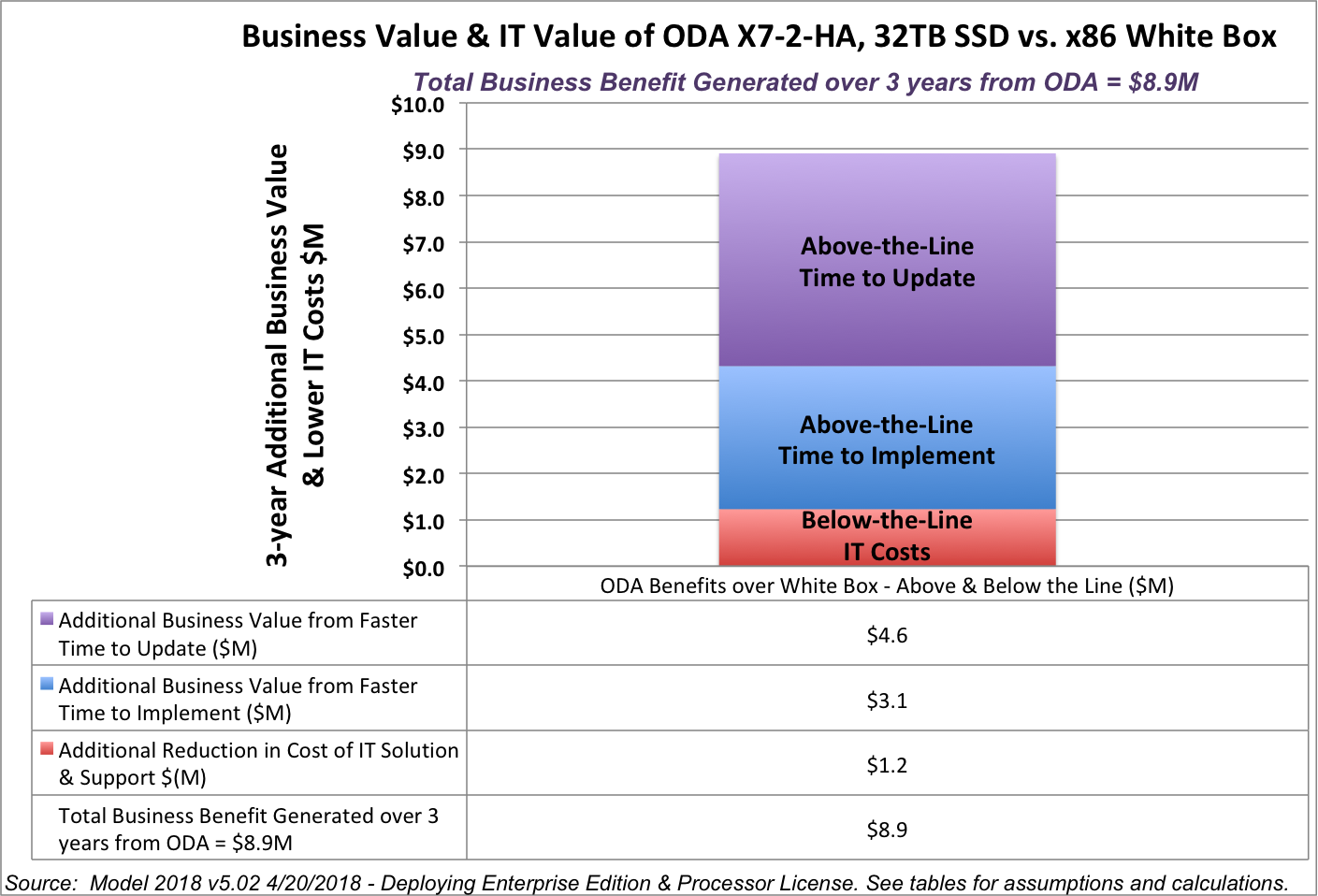
Source © Wikibon 2018
Our analysis shows that the Hyperconverged Full Stack approach has a net benefit of $8.9 million with a net present value of $8.2 million (5% rate of discount) compared to a traditional x86 White Box approach. The analysis shows the White Box has 57% higher IT costs over 3-years than a Hyperconverged Full Stack Appliance in a distributed high-value application environment. The Wikibon research also shows above-the-line business benefits of improved time-to-value from a hyperconverged Full Stack Appliance are over 5 times greater than the IT operational cost benefits.
Most enterprises are adopting a hybrid cloud strategy, with multiple private and public clouds. Wikibon concludes that the traditional enterprise strategy of building and maintaining low-cost x86 white box piece-part infrastructure is unsustainable in a modern hybrid cloud world. Future improvements will include significant contributions from automation and optimization. Both need large amounts of technical information from multiple installations. Vendors who deliver integrated hyperconverged automation and optimization solutions in volume will be best positioned to deliver and continuously improve solutions.
Wikibon believes that executive management needs to focus on eliminating undifferentiated IT manual labor, and develop strategies to improve the contribution of IT to the business. Focus areas are time-to-value for new applications, improved security, compliance and availability, and improved ability to implement system and application updates faster. Hyperconverged Full Stack solutions such as ODA will provide a significant contribution to these objectives.
The difference between below-the-line IT benefits and above-the-line business benefits is explained in the next section.
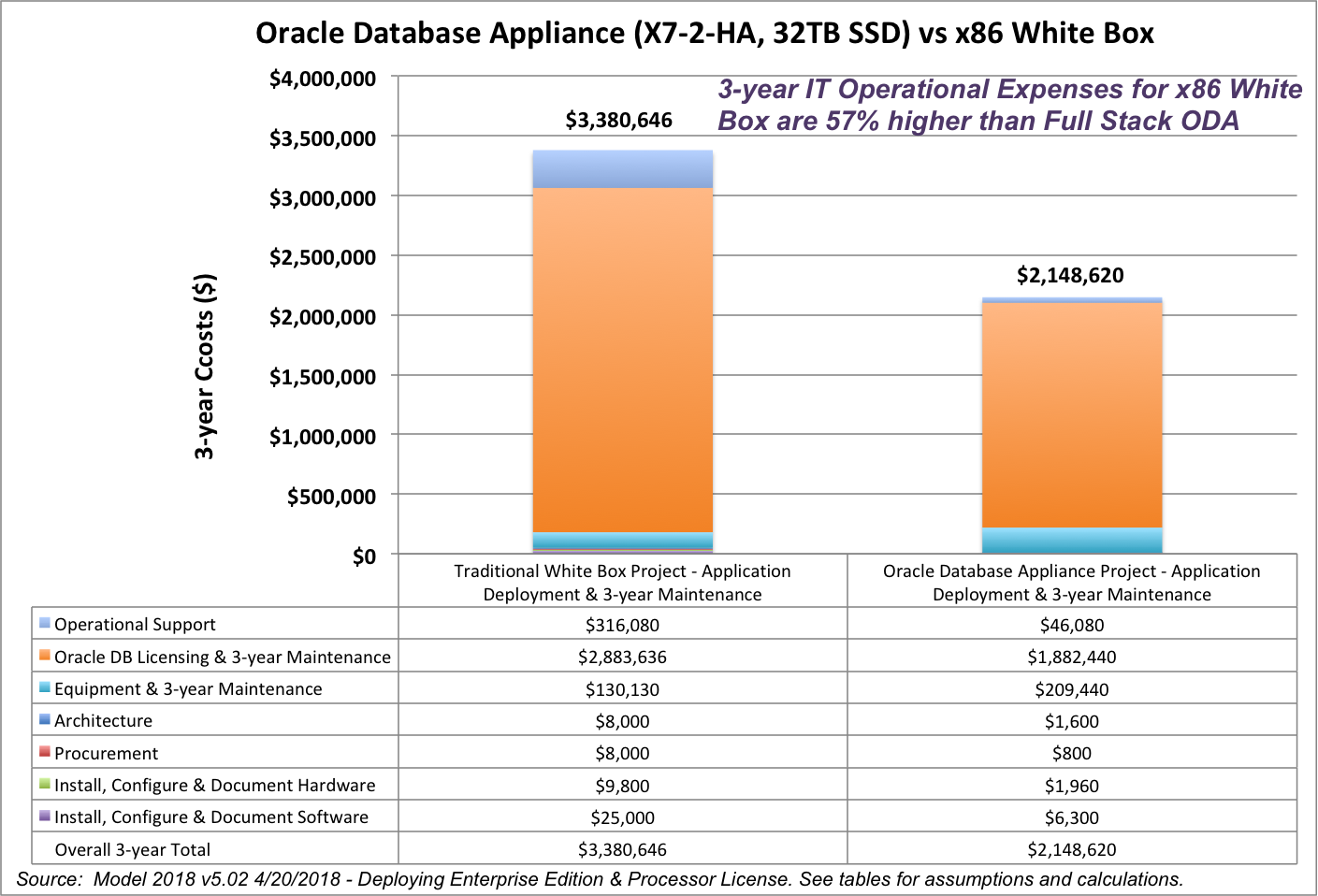
Source © Wikibon 2018
Understanding Total Cost of Ownership
“Below-the-Line” TCO Analysis
* “Below the line” is a term used in finance to refer to operating expenses. Figure 2 above is a list of the operating expenses of a computer system running a high-value system of record application. The hardware costs are assumed to be slightly higher for the ODA than a White Box, but the software and support costs are much lower. Overall, in our example, the IT operational expenses for a x86 White Box environment are 57% higher than the hyperconverged Full Stack ODA solution.
This result correlates highly with other Wikibon convergence-related studies that have consistently shown that converged and hyperconverged solutions sold as an integrated solution (one hand to shake, one throat to choke) are significantly lower in IT operational cost.
“Above-the-Line” TCO Analysis
* “Above-the-line” usually refers to product related finance. In IT, this term refers to benefit categories that are related to the operation of the enterprise by the line-of-business itself. These benefits are often referred to as “soft dollars”.
Time-to-value is one example of an above-the-line business benefit. Figure 3 below shows the detail behind the finding that deploying an application on an ODA can result in the application being available 5 times faster than a do-it-yourself x86 White Box system. Table 2 below shows more detail in how the data was calculated.
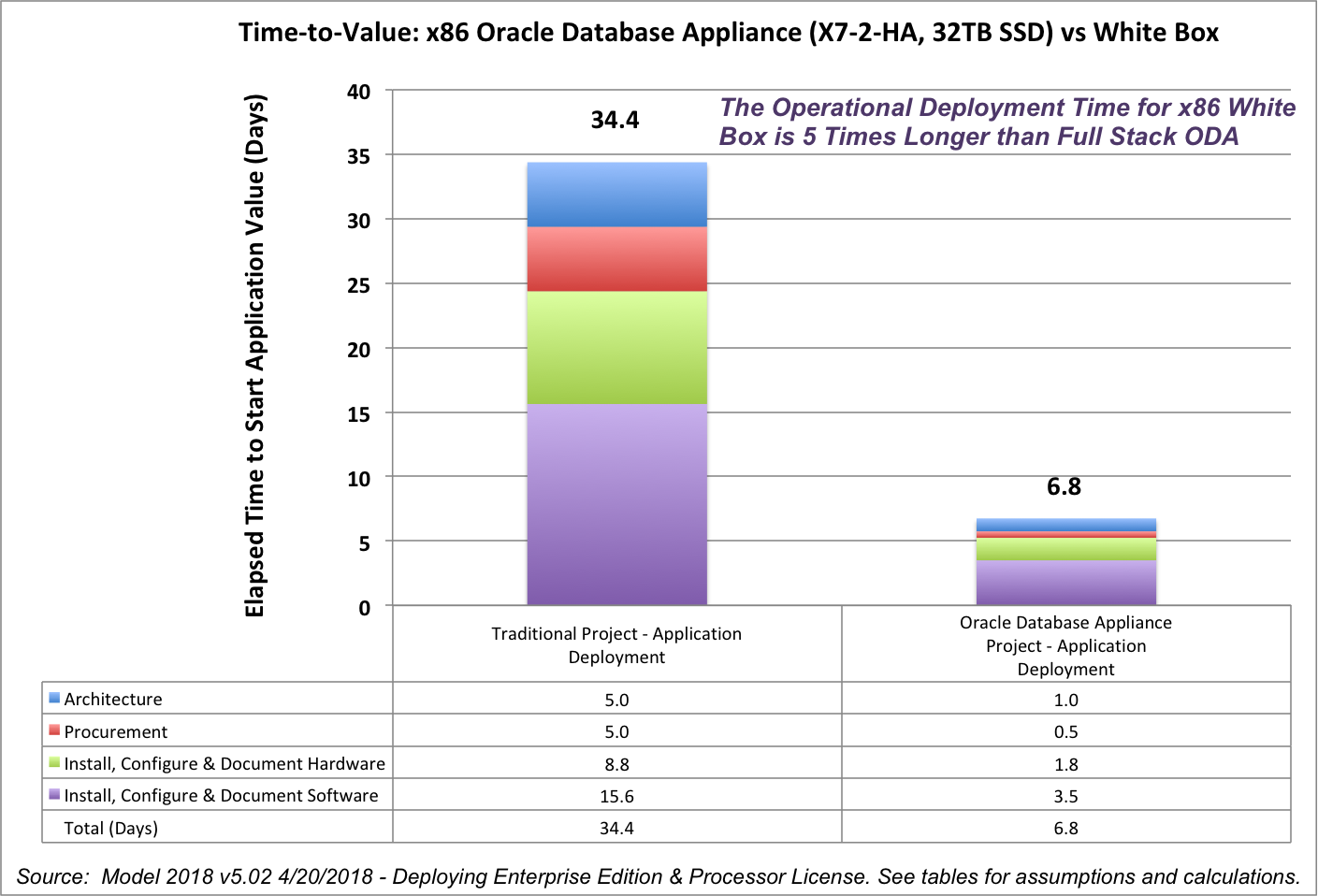
Source © Wikibon 2018
The challenge of above-the-line benefits is expressing the value of these benefits in dollar terms. In the next section we look at a specific methodology developed by Wikibon to help IT departments express above-the-line benefits.
Two particular benefits are assessed in detail. They are:
- The financial benefits of faster time-to-value, as discussed in Figure 1 and Figure 3.
- The benefit of quarterly updates to the complete hyperconverged Full Stack on which the application runs. This enables pre-tested patches and upgrades to be applied as a single logical job earlier, more often, and more quickly and easily. This results in the business benefits of improved system and application functionality being realized earlier.
This methodology is explained and applied in the next section.
Business Value Methodology
This report builds on previous research by Wikibon on Full Stack analysis, and extends it to look at the above-the-line business benefits that are available to the enterprise. Table 1 below shows the detailed line items, assumptions and the calculations used to derive the benefits shown in Figure 1 above.
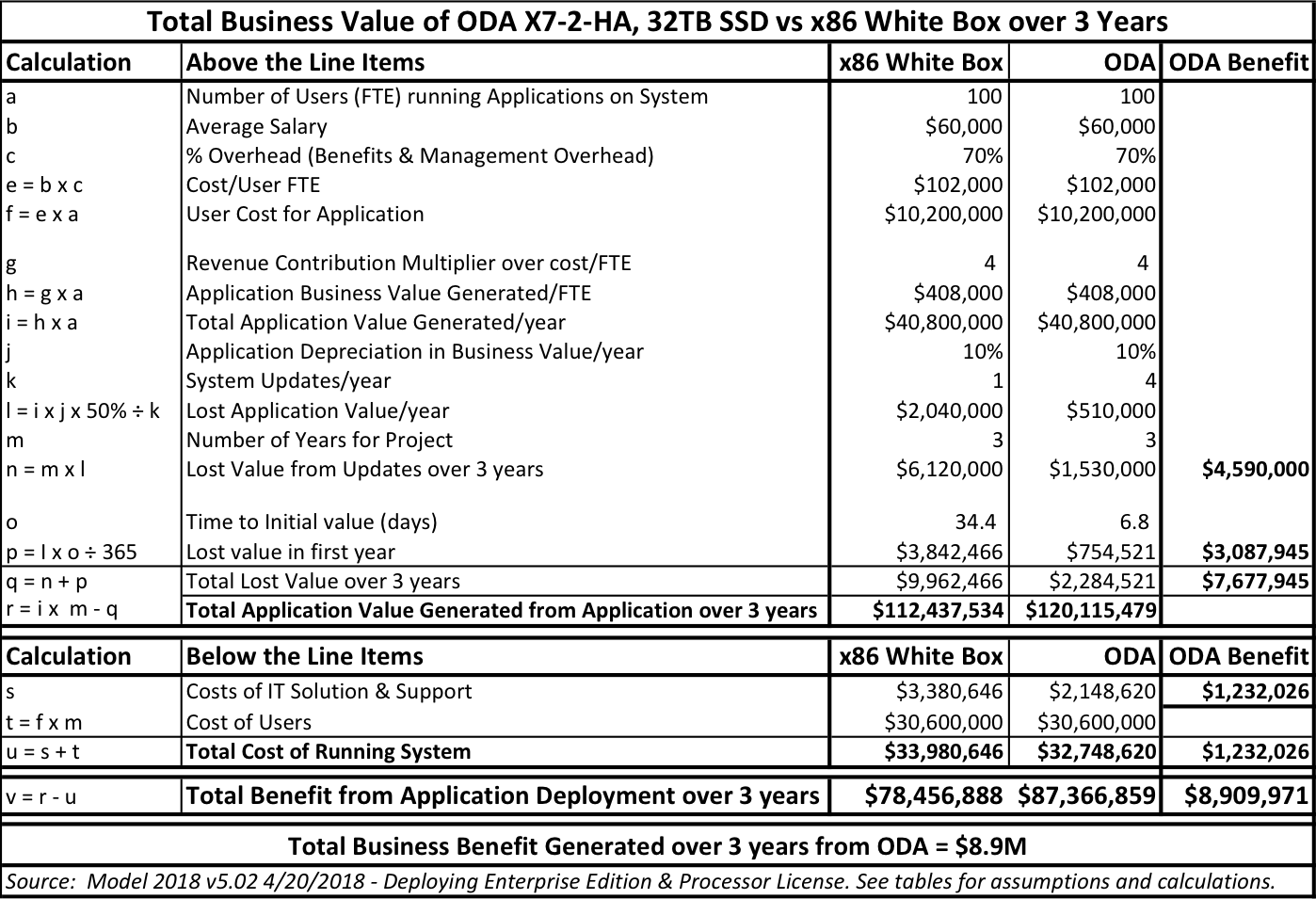
Source © Wikibon 2018
Line “a” in Table 1 shows the assumption that the application is being used by an average 100 full time equivalent (FTE) staff in the organization at any one time (typically there will be a much larger number of users using the application some of the time). Line “f” in Table 1 shows the fully burdened cost of the 100 FTEs of $10.3 million/year.
Line “i” in Table 1 shows the calculation of application value. It is based on Wikibon research which shows that the average contribution of an employee to the revenue generated by an organization is 4 times the fully burdened salary. Wikibon assumes that the contribution of the employee while they are using the IT application is as high as any other business activity, and therefore should be 4 times the fully burdened salary. Line “i” is $40.8 million/year.
Wikibon research also shows that applications decline in value by about 10%/year, as a result of business changes and changes in the overall business environment. Work is required to maintain the application and infrastructure environment to maintain the business value of the application, and the productivity of the users. In a traditional white-box environment it is assumed that these updates and upgrades are added once a year. The ODA approach allows a full integrated upgrade to take place every quarter. Line “l” in Table 1 calculates this loss of value in both environments (for geeks: the 50% in the formula reflects that at the end of the year the value is 10% less, and that the average loss over the year is 50% of the value at the end of the year) . The difference in value lost to application decline ($4.6 million over 3 years) is shown in line “n”.
Line “o” shows the difference in time to implement the project, and is derived from the analysis in Table 2 below. The ODA hyperconverged Full Stack approach is 27 days quicker to implement, and 27 additional days of application value is generated. This additional value is calculated in line “p” of Table 1, to give a benefit of $3.1 million in the first year.
The differences in IT costs in line “s” are derived from Table 2. Line “u” shows the $1.2 million net savings to the IT budget, a below-the-line saving.
Line “v” in Table 1 shows the value of using a hyperconverged Full Stack system in terms of both increased application value (above-the-line) and decreased cost (below-the-line) to be a total of $8.9 million over 3 years.
ODA Hyperconverged Full Stack
The Oracle Database is designed for extremely high availability Oracle database applications with a high business value. The applications deployed are often core enterprise systems of record that are essential for running the business. If these applications go down, the business goes down. The Oracle Database is recognized as the highest function database in the market, and the most widely deployed for these types of applications.
The Oracle database has traditionally been run on premise. Increasingly, Oracle database is being run in the Oracle Cloud, or in a Oracle cloud-on-premise solution.
The Oracle Database Appliance (ODA) allows the Oracle database to provide a distributed smaller-scale system, with very high software and hardware availability characteristics. As such it enables ease-of-use locally, and the ability to be fully managed remotely. It allows full integration into the Oracle cloud for services such as backup and recovery. One unique capability is the guarantee of database integrity across private and public clouds.
The reference configuration is built from two ODA X7-2-HA base systems. Altogether, the two systems provide 144 cores and 42.4 terabytes of storage. It provides sufficient redundant capacity across two locations for a peak of 200 FTE employees or customers actively using the system, with a peak-to-average ratio of 2.
Each ODA X7-2-HA is a hyperconverged Oracle Engineered System that integrates compute, storage, and network resources with a full stack of Oracle software services. The software includes hypervisor (OVM or KVM), Oracle linux operating system, Oracle database and appliance manager. OVM is deployed in the reference system. Each X7-2-HA reference system has a total of 72 cores and 786 GB of DRAM from two servers each with 2 sockets.
Each ODA X7-2-HA configuration is a base system, which can be expanded. The base system has a total of 21.2 terabytes storage capacity from a total of 13 SSDs. There is 16 terabytes of shared raw storage between the two servers from five SSDs. 3.2 terabytes shared storage is dedicated to Redo Logs from 4 SSDs. 1.9 terabytes of storage is dedicated to Operating System and Oracle Database software from two internal M.2 SATA SSDs (mirrored) per server.
There are 24 Oracle software licenses for the Oracle database configuration across the two ODA X7-2-HA systems, and 48 of the 144 cores are licensed. The Oracle database is Enterprise Edition DB, with Diagnostic Pack, Tuning Pack, Active Data Guard, and Real Application Clusters (RAC). A discount of 50% is assumed on the Oracle list price.
The ODA has fully redundant power, cooling and equipment. The service processor includes Oracle Integrated Lights Out Manager (Oracle ILOM) and Oracle auto service request (ASR). The appliance manager is designed to fully manage the software, allow itself to be managed remotely, and be part of Oracle Cloud network. It also drastically simplifies maintenance by patching the entire appliance, including all firmware and software, in one operation, using a pre-tested patch bundle specifically engineered for the specific appliance.
ODA has some specific functionality that is integrated with the Oracle database, and not available on x86 white box servers. These are:
- Hybrid Columnar Compression: This is useful in a data warehouse environment, and can compress the Oracle Database storage requirements. This capability depends on knowledge of the Oracle Database structure, which is unique to Oracle Engineered Systems. It is less useful in OLTP applications, which are usually row-orientated.
- Oracle Database Snapshots: This is a very useful feature. Classic snapshots need to quiesce the database and flush the buffers. Because of tight integration between the software and hardware, the Oracle DB snapshots do not need the database to be paused, and are almost instantaneous. This enables more frequent snapshots to be taken, and enables improved RPO and RTO SLAs.
- Guaranteed Database Integrity for Cloud Backup: The ability to check the end-to-end integrity of the data is enabled by database software and systems hardware.
- Built-in Local & Remote Monitoring: The Oracle ILOM and ASR functions are discussed above.
A full analysis of the configuration and line item costs is given in Table 2 below. Further technical information is available from Oracle.
x86 Traditional White Box
The x86 white box comparison is a build-it-yourself configuration with the same or equivalent components, and provides the same total amount of CPU, storage and network capacity. 72 cores (one socket per server) of the 144 cores are licensed for Oracle database software. The hardware cost is a assumed to be 35% less than the ODA configuration. The full details of the configuration, software and hardware prices are given in Table 2.
The White Box system is configured to be highly redundant. The automation from local and remote monitoring capability is not included.
A full analysis of the configuration and line item costs is given in Table 2 below.
IT Costs Calculations
Table 2 below gives the detailed IT cost assumptions and calculations. The overall IT cost figures are used in Table 1. The detailed IT people cost calculations of the hours to architect, procure, install the hardware and software, and maintain the hardware and software are used in Table 1.
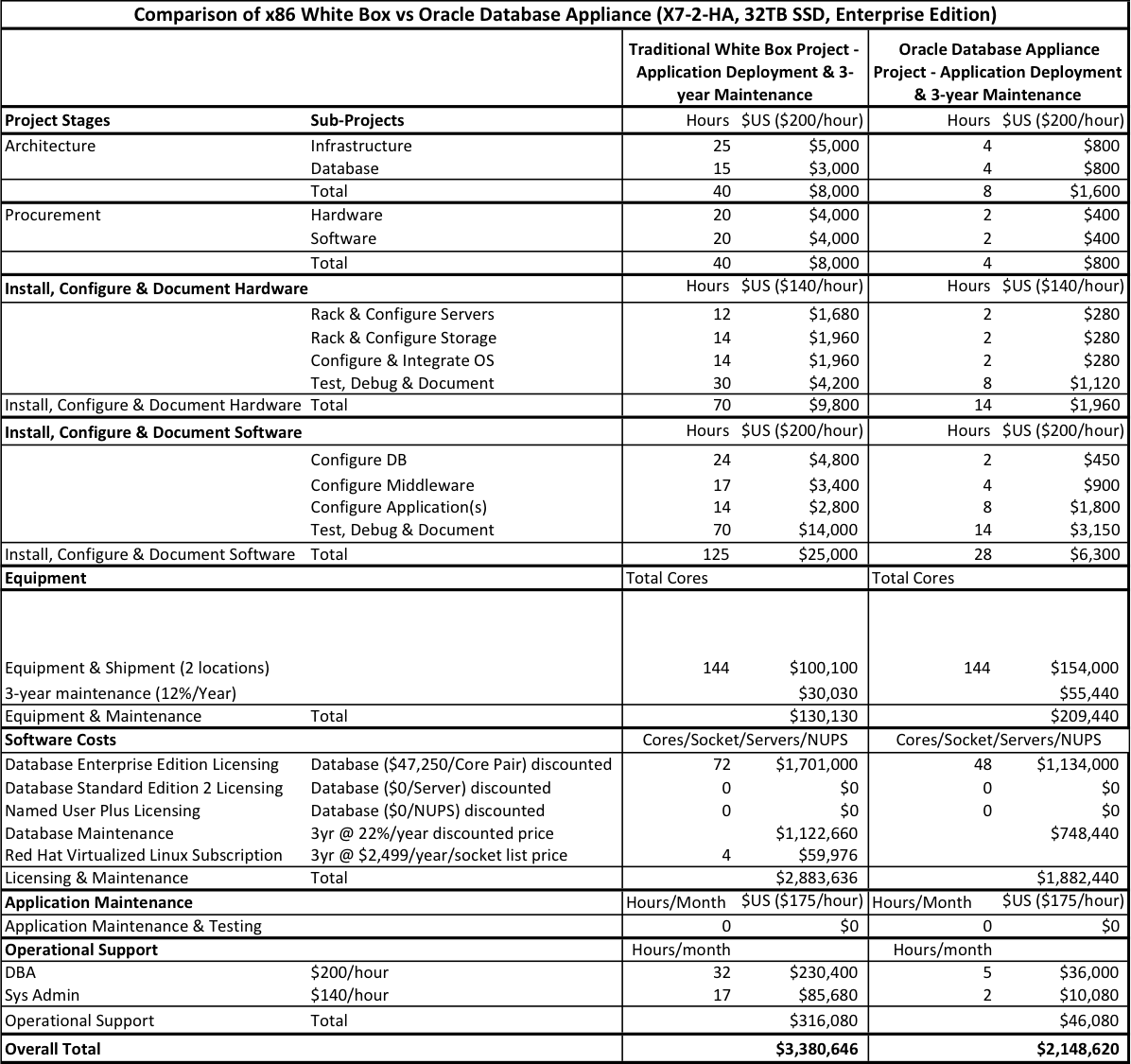
Source © Wikibon 2018
Business Case Analysis
Table 3 below shows the business case comparing a hyperconverged Full Stack ODA solution with a traditional White Box approach.
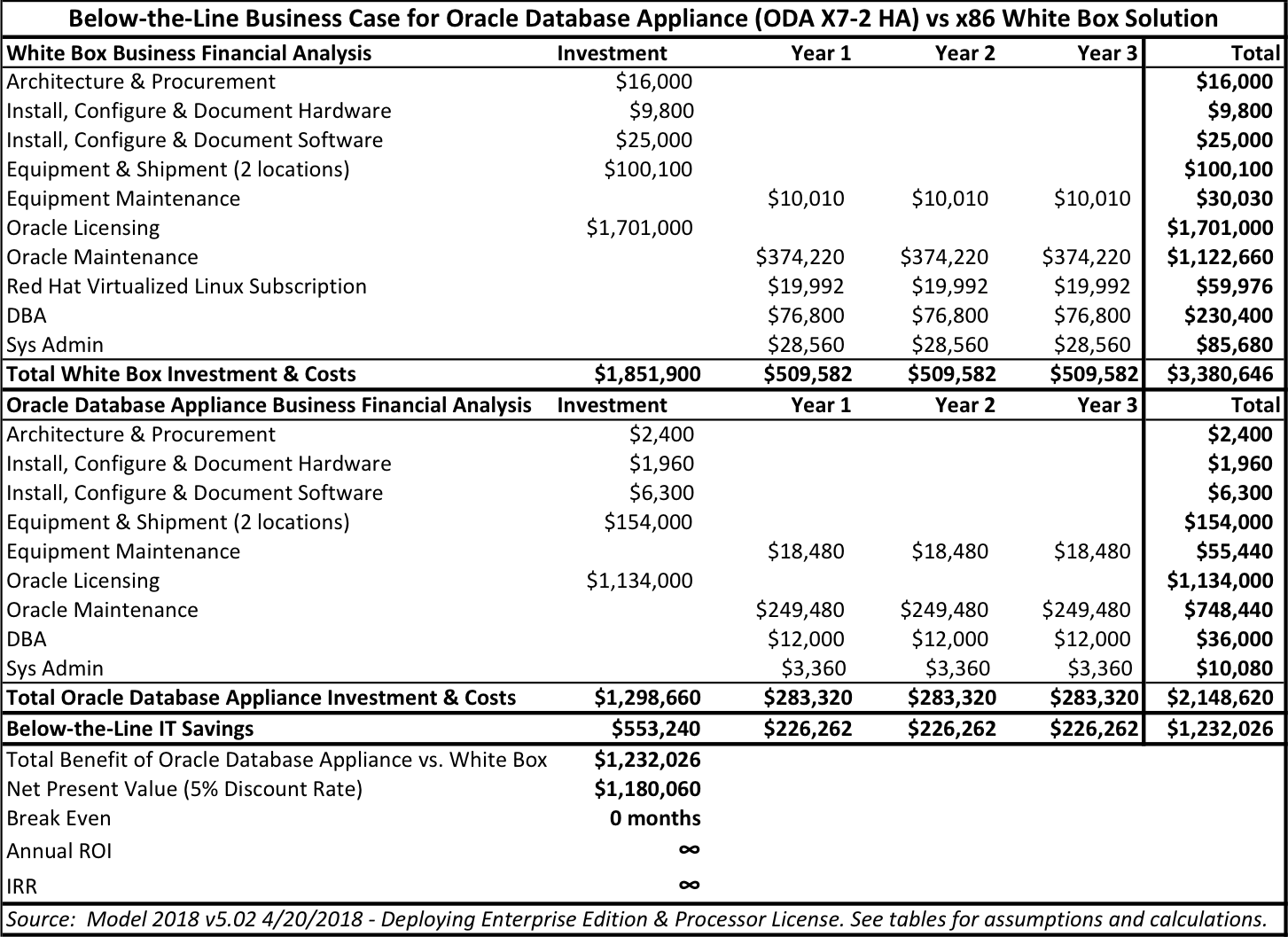
Source © Wikibon 2018
Table 3 shows that the below-the-line IT savings from adopting a hyperconverged Full Stack approach is $1.2 million over three years.
Table 4 below shows the business case for both above-the-line and below-the-line items, and shows the total business case for implementing the application. It shows that the total 3-year business benefits of implementing the application are $87.4 million using a Full Stack approach, and $78.5 million deploying a traditional White Box approach.
The analysis shows an overall benefit of $8.9 million to deploy a hyperconverged Full Stack approach, using ODA. The net present value is $8.3 million (5% rate of discount).
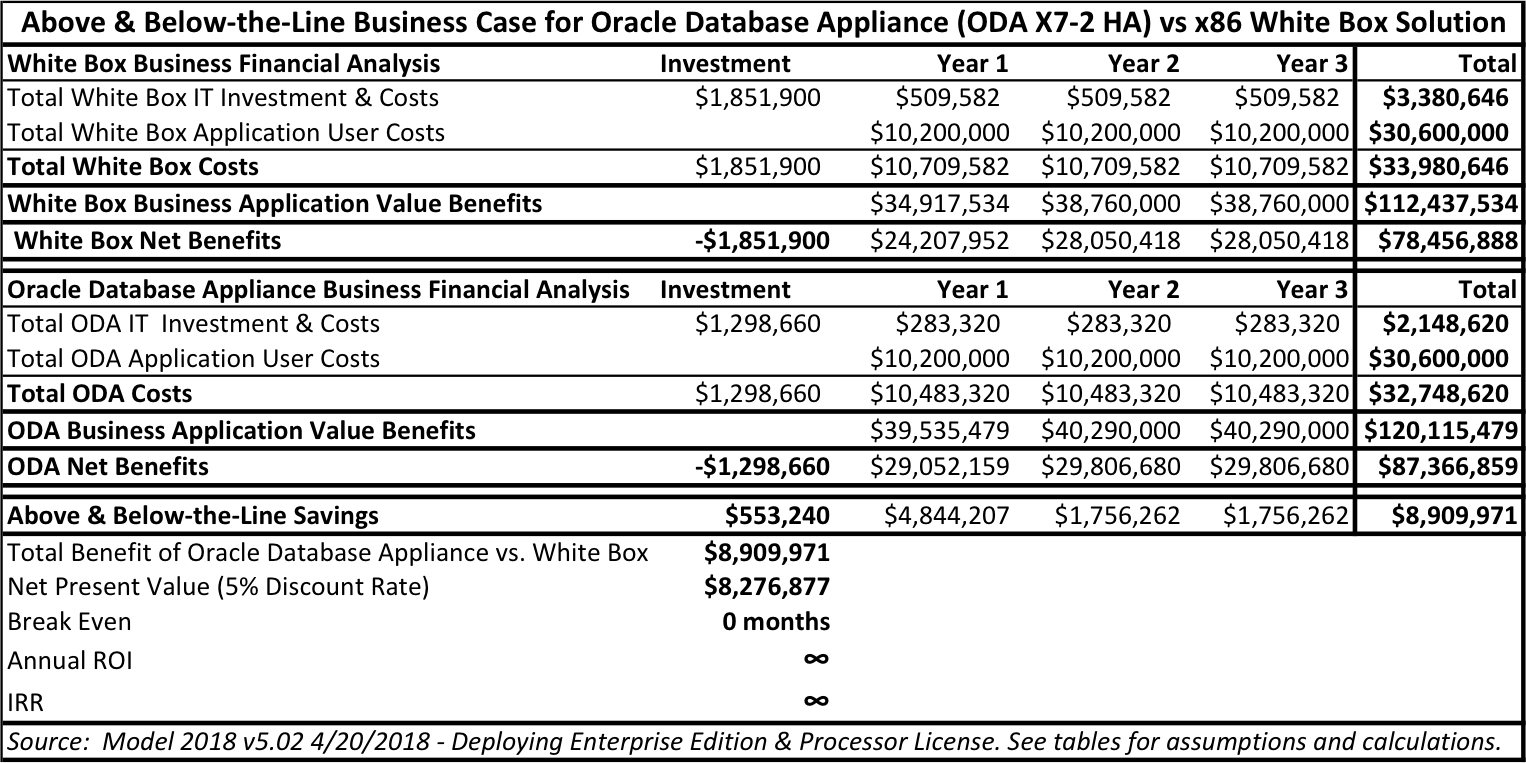
Source © Wikibon 2018
This analysis is a conservative view of business value since it does not take into account the higher availability and recoverability of a hyperconverged Full Stack solution, or the potential benefit of high productivity from improved response times using an integrated ODA approach.
Discussion and Conclusions
Most enterprises are moving to a hybrid cloud strategy connecting multiple private and public clouds, as there are practical and compliance requirements for processing to be close to data. Wikibon has projected that “True Private Clouds” will be the major component of the cloud industry. A key characteristic of True Private Clouds is that they are converged or hyperconverged, and that a single vendor is responsible for providing this solution. Key requirements are a single hand to shake (for initial deployment, maintenance and upgrades) and a single throat to choke. ODA is an example of a True Private Cloud.
The biggest challenge of distributed computing is IT cost. IT is always labor intensive, and the challenges are magnified with the unavailability of skills in distributed environments. When advanced database systems requiring high availability are distributed the challenge is amplified. Much of the labor allocated to remote infrastructure and database system management is undifferentiated investment.
The solution is to have distributed systems that are simple to set-up and simple to run. All aspects of support need to be automated, and remote operation a prerequisite. Fully integrated stack systems such as Oracle Database Appliance have changed the game by lowering operational costs by at least 30% or more relative to DIY systems based on white boxes. This is the “below the line” benefit, the direct savings in IT cost.
The business value of an integrated solution shows up even more when the above-the-line business benefits are taken into account. The reason for implementing IT projects is to improve the productivity, improve the revenue, and reduce the risks to the business.
In terms of risk, it is worth noting that the credit bureau Equifax failed to update its system with a patch issued in March 2017. As a result, the sensitive data of 143 million Americans was hacked in May 2017, and hundreds of thousands of identities were stolen – at a great cost to Equifax’s brand reputation. This analysis shows that much larger benefits can be derived from faster time-to-value, and faster and more frequent updating of systems and applications.
The strategic solution to risk is continuous improvement of system automation. Vendors have more data and more expertise in developing AI versions of system automation and rapid recovery for True Private Cloud Solutions.
Action Item
Most enterprises are adopting a hybrid cloud strategy, with multiple private and public clouds. Wikibon’s research shows below-the-line IT operational costs for unique Do-It-Yourself x86 server infrastructure has 57% higher costs over 3-years than a Hyperconverged Full Stack Appliance for distributed high-value application environments. The research also shows above-the-line business benefits of improved time-to-value, availability, security, and compliance delivered by a Full Stack Appliance are over 5 times greater than the operational costs.
The enterprise strategy of building and maintaining low-cost x86 white box piece-part solutions is unsustainable in a modern hybrid cloud world. Future improvements in operational cost, availability, security, and compliance will come incrementally from Full Stack vendors such as Oracle providing greater integration and automation.
Wikibon believes that executive management needs to focus on strategies to eliminate undifferentiated IT manual labor, to improve time-to-value for new applications, to improve security and availability, and to implement system and application updates faster. Wikibon strongly recommends implementing True Private Clouds with an integrated hyperconverged full stack, together with integration with public clouds.
Wikibon strongly recommends high-value Oracle database applications that need to be distributed should be deployed on Hyperconverged Full Stack systems that meets the definition of True Private Cloud. Wikibon strongly recommends the Oracle ODA be always included in RFPs for high-value distributed applications using Oracle databases.


